
1-May-16
1
Continue. Of Occup. Med. Lectures
(4
th
.5
th
.6
th
. Lectures / / )
OCCUPATIONAL HEALTH HAZARDS
``Source or situation with a potential for
harm in terms of injury or ill health,
damage to property, damage to the
workplace environment, or a
combination of these``

1-May-16
2
OCCUPATIONAL HEALTH HAZARDS
TYPES OF OCCUPATIONAL HEALTH
HAZARDS
A. Physical
B. Chemical
C. Biological
D. Mechanical
E. Psychosocial

1-May-16
3
CHEMICAL HAZARDS
•
Routes of entry - Inhalation, Ingestion, skin
absorption. (inhalation is the main route of entry)
**Chemical agents can be
classified
into-
1)
Metals
- Lead, TEL, As, Hg, Cd, Ni , Co etc.
2)
Aromatic Hydrocarbons
- Benzene, Toluene, phenol
etc.
3)
Aliphatic Hydrocarbons
- Methyl alcohol
4)
G
ases
- *Simple asphyxiants : N2, CH4, CO2
* Chemical asphyxiants : CO, H2S, HCN
* Irritant gases : Ammonia, SO2, Cl2,
* Systemic poison : CS2
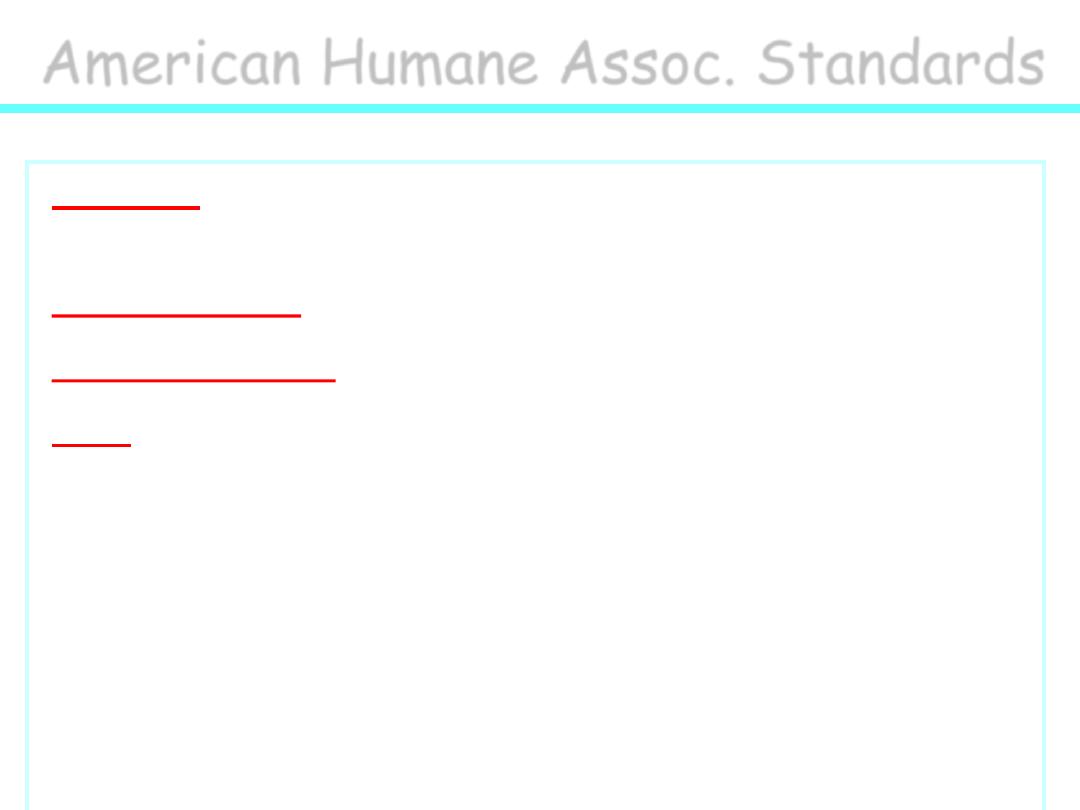
1-May-16
4
American Humane Assoc. Standards
•Ammonia
. <10 ppm ideal, not exceed 25 ppm.
Measure & record weekly
•Carbon dioxide
. <5000 ppm
•Carbon monoxide
. <150 ppm
•Dust
. < 5 mg/cu m (respirable) and <15 mg/cu m (total)

1-May-16
5
Carbon Monoxide
The “Invisible Killer”
“ CO ”
2007 NNEPC

1-May-16
6
What is Carbon Monoxide
Poisoning?
CO is a colorless, tasteless, odorless nonirritating gas
produced when sources of carbon, such as fuels or
wood are burned

1-May-16
7
Carbon Monoxide (CO)
vs.
Carbon Dioxide (CO
2
)
Carbon Monoxide
Carbon Dioxide
A byproduct of burning
fuels
Gas exhaled with normal
breathing
A poison even at low doses An asphyxiant and
poisonous at high doses

1-May-16
8
Who is at Risk?
• EVERYONE, especially:
– People using
alternate
heat sources during power outages
– Elderly
– Unborn babies, infants,
– Individuals with chronic heart disease, anemia or
respiratory problems

1-May-16
9
Who is at risk? Cont…..
– Personnel at fire scenes (fire-fighters/rescue
workers)
– Individuals working with combustion engines or
combustible gases indoors
– Industrial workers at pulp mills, steel foundries and
plants producing formaldehyde and coke
– Pets

1-May-16
10
Sources
• Burning fuels such as: wood, oil, natural gas, gasoline,
kerosene, propane, coal and diesel
• Electrical appliances do not produce CO
• Common sources of human exposure include:
– Smoke inhalation from fires
– Automobile exhaust
– Faulty or poorly vented charcoal, kerosene or gas
stoves
– To a lesser extent, cigarette smoke and methylene
chloride (industrial uses)

1-May-16
11
Cold Weather Hazards
• Insufficient ventilation
– Generators used inside during a power outage
– Gas or kerosene heater in room without proper
ventilation
– Stoves or fireplaces that are improperly vented or
blocked
– Exhaust flues or appliance ducts that are blocked or
sealed shut
– Cars or trucks idling in a garage
• Opening the door is not sufficient

1-May-16
12
Warm Weather Hazards
• Enclosed area (poor ventilation)
– Gas, kerosene, charcoal, propane or hibachi grills
– Gasoline-powered equipment (lawnmower,
chainsaw, generator), used in a home, garage or
under a tarp
– Gas-fueled lanterns and stoves burned inside a
tent, trailer, boat cabin without proper ventilation
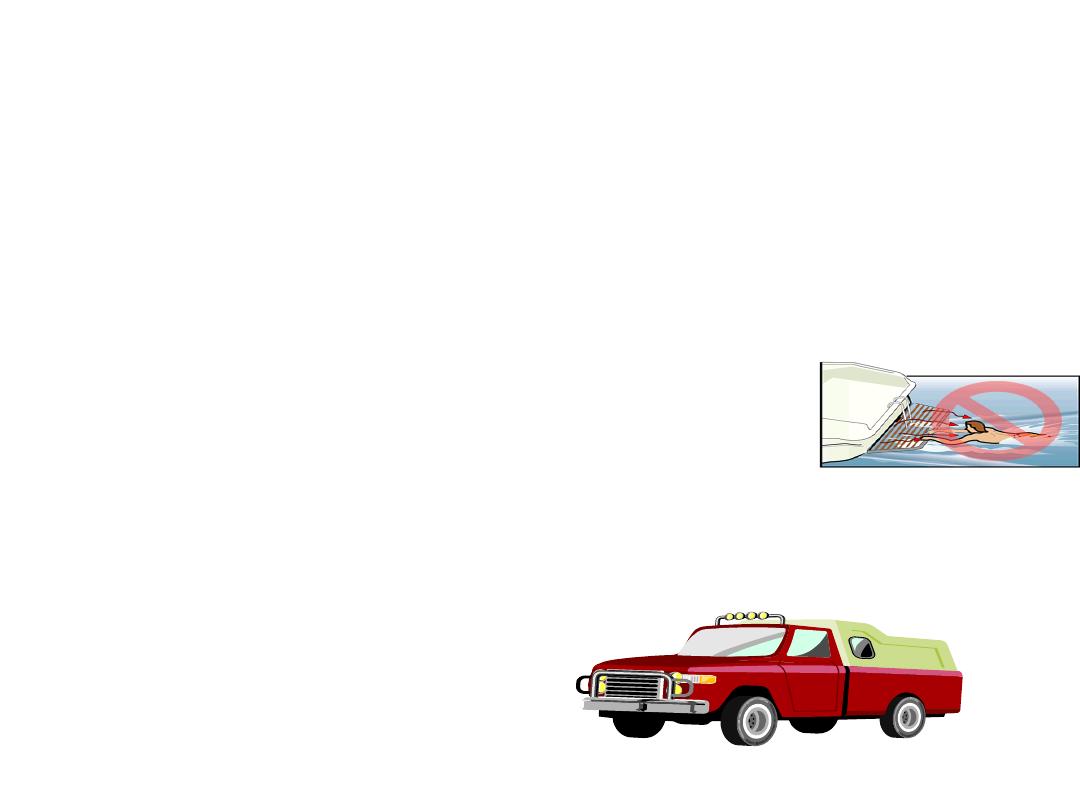
1-May-16
13
Warm Weather Hazards cont…
• Excessive inhalation of exhaust
fumes
– Teak surfing or pulling a skier from a boat’s
diving platform
– Diving from or swimming near a houseboat
platform
– Riding in the back of a pickup truck with a
camper shell
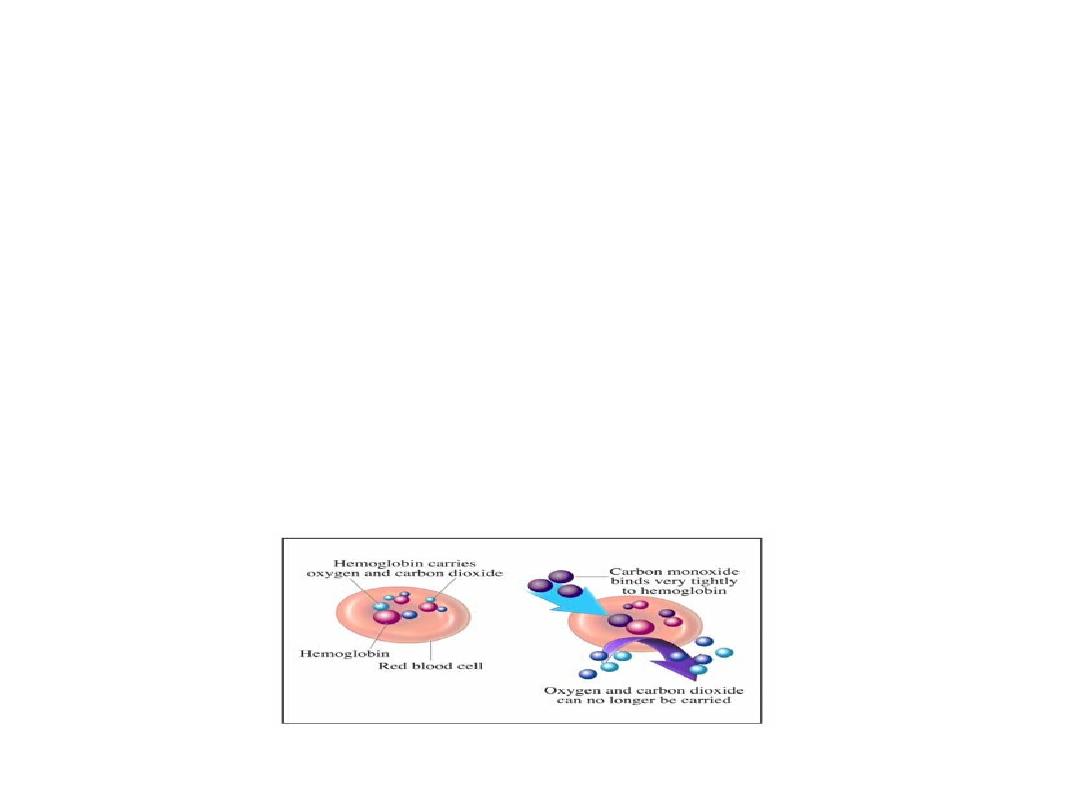
1-May-16
14
How does Carbon Monoxide
Poisoning Work?
Enters the body through the lungs and is delivered to
the blood
• Red blood cells pick up CO instead of oxygen
– Hemoglobin likes CO 250 times more than oxygen
• CO prevents the oxygen that is present from being readily
released to and used properly by tissues

1-May-16
15
Why Do We Need Oxygen?
• Brain damage
– Can only live a few minutes without oxygen.
• Organ damage
– Vital organs such as brain and heart need
oxygen
• Possibly death

1-May-16
16
Toxic effects =
Concentration X Exposure
May
=
Long-term
exposure to low
levels of CO
Short-term
exposure to high
levels of CO

1-May-16
17
Signs and Symptoms
• Flu-like symptoms (without fever or runny nose)
including:
– Headache
– Fatigue/sleepiness
– Shortness of breath
– Nausea
– Dizziness
– Confusion or disorientation
• Young children, elderly and household pets are
usually effected first

1-May-16
18
Failure to Detect Danger
• Often mistaken for the flu, food poisoning or other
illnesses
• Those sleeping or intoxicated can die before
experiencing any symptoms
• Prolonged exposure can lead to brain damage and
death
• Victims may become disoriented and unable to
save themselves

1-May-16
19
Prognosis
• Difficult to predict the long-term effects of CO
poisoning/exposure.
– Even with proper medical treatment a few people can
develop long-term brain damage.
– Some individuals appear to have no long-term affects.
• If pregnant, fetal complications or death may
result.

1-May-16
20
Carbon Monoxide Alarm
Your best protection!
• Install a carbon monoxide alarm close to sleeping
areas. For more protection:
– Install one in every bedroom
– Install one on every level of your home
• Never ignore a carbon monoxide alarm, IT
COULD SAVE YOUR LIFE!
• Visit or click here for more information:
http://www.cpsc.gov/cpscpub/pubs/466.html

1-May-16
21
Maintaining Alarms
• If battery powered
– Check monthly
– Replace batteries every year or when batteries
are low
• If electric, make sure there is battery backup
in case of power outages.

1-May-16
22
Prevention Tips: Don’t…
• Never run a portable generator, gasoline-powered
engines (such as mowers, snow-blowers,
chainsaws) or burn charcoal in:
• Never leave a car, mower or other vehicle running
in a garage, even with the door open
• Do not heat home with gas oven.
- Crawlspaces
- Indoors
- Garages
- Basements
- Closed in porch
- Vehicle
- Tent
- Under windows

1-May-16
23
Carbon-Dioxide
• Has no odor.
• Heavier than air.
• TLV exposure limit is 5,000 ppm.
• Can cause death by asphyxiation
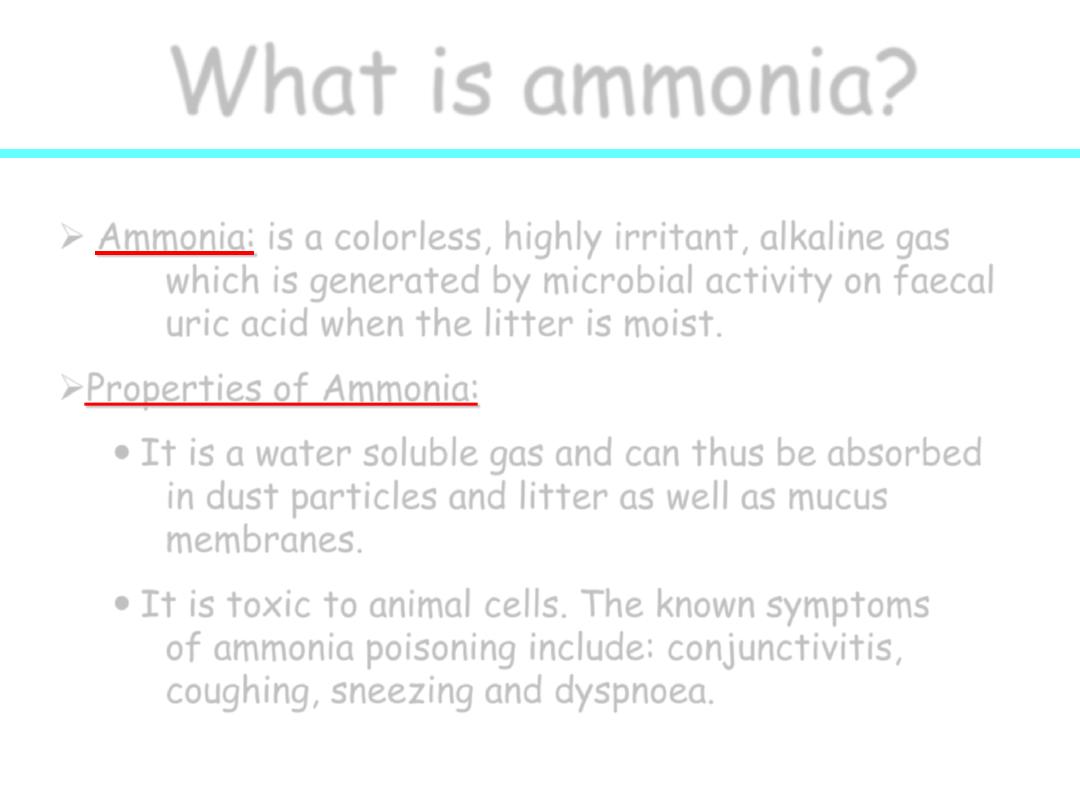
1-May-16
24
What is ammonia?
Ammonia:
is a colorless, highly irritant, alkaline gas
which is generated by microbial activity on faecal
uric acid when the litter is moist.
Properties of Ammonia:
It is a water soluble gas and can thus be absorbed
in dust particles and litter as well as mucus
membranes.
It is toxic to animal cells. The known symptoms
of ammonia poisoning include: conjunctivitis,
coughing, sneezing and dyspnoea
.
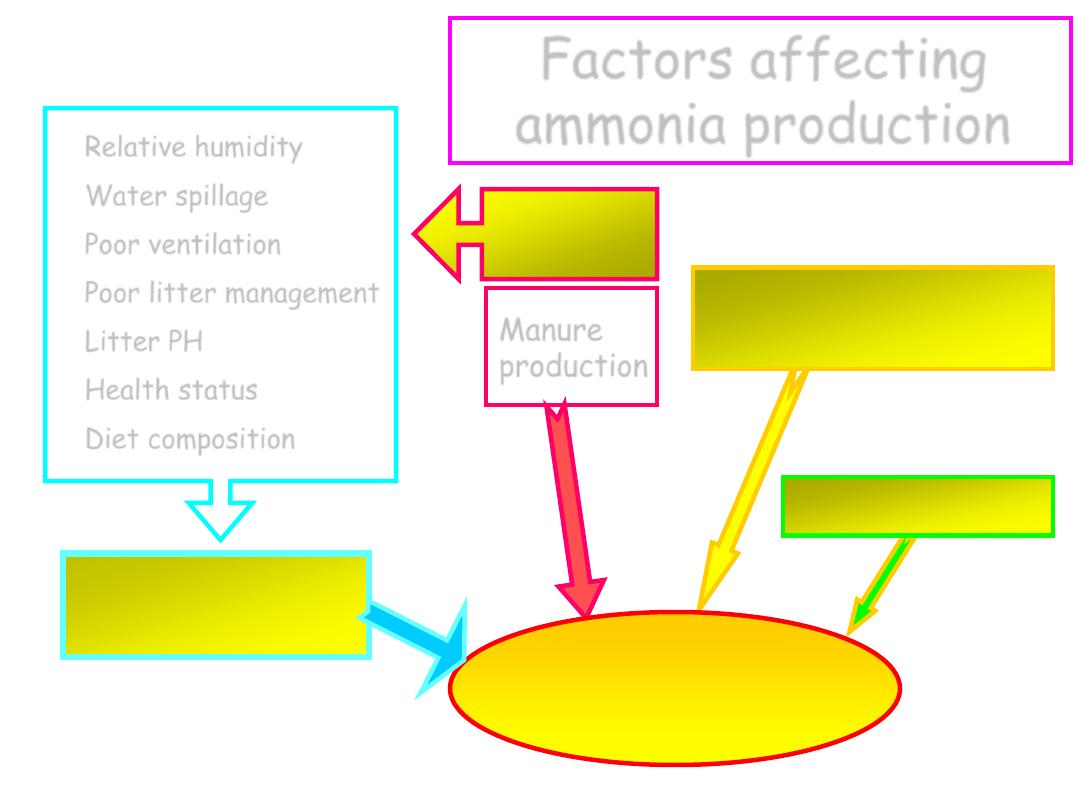
1-May-16
25
Factors affecting
ammonia production
High litter
moisture
Litter depth,
composition and PH
Density
Relative humidity
Water spillage
Poor ventilation
Poor litter management
Litter PH
Health status
Diet composition
High ammonia
Manure
production
House floor

1-May-16
26
Ammonia
• Odor detection limit 1-5 ppm
• Irritating 50 ppm (eyes),
• 100 ppm (respiratory tract)
• TLV 25 ppm
• Lethal 10,000 ppm
• Irritant in nature
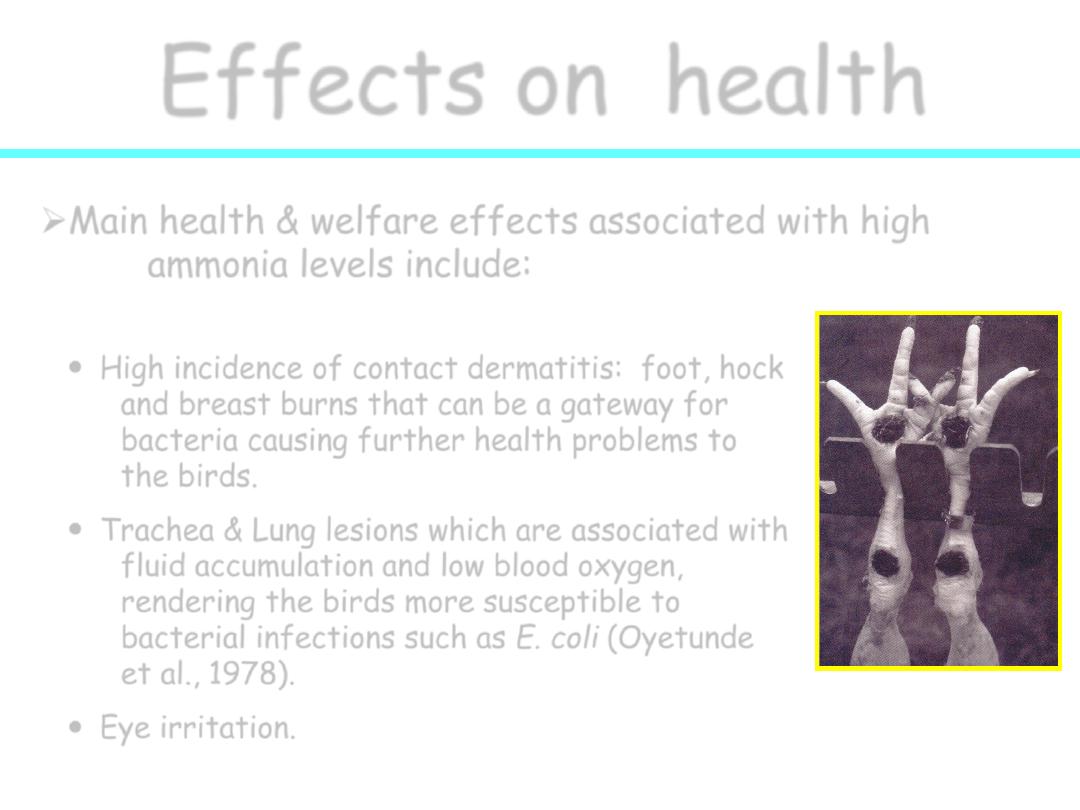
1-May-16
27
Effects on health
Main health & welfare effects associated with high
ammonia levels include:
High incidence of contact dermatitis: foot, hock
and breast burns that can be a gateway for
bacteria causing further health problems to
the birds.
Trachea & Lung lesions which are associated with
fluid accumulation and low blood oxygen,
rendering the birds more susceptible to
bacterial infections such as E. coli (Oyetunde
et al., 1978).
Eye irritation.

1-May-16
28
Effects on human health
“ increase the susceptibility of the
respiratory system to airborne
pathogens synergistically at
concentrations below the
occupational exposure limit of
25ppm”
Aerial pollutants and the health of poultry farmers. Whyte,
WPSJ 1993.

1-May-16
29
Effects on human health*
•Dose-response study of 257 poultry workers to
exposure to dust, endotoxin and ammonia
•Ammonia exposure levels ranged from 0-75 ppm with
21% of workers exposed to levels exceeding 25 ppm
TWA
•Concluded threshold concentration for human health
(no impaired respiratory function) inside houses is 12
ppm
*
Occupational health hazards and recommended exposure limits for workers in
poultry buildings. Donham, NPWMS, 2000.
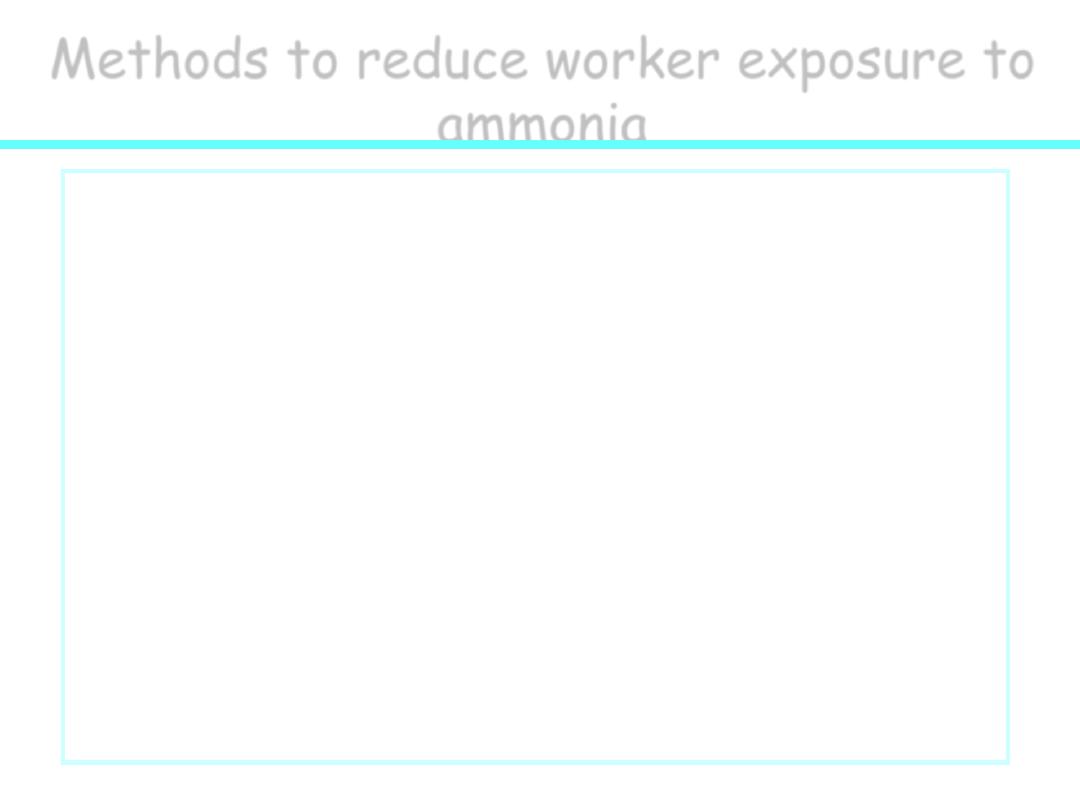
1-May-16
30
Methods to reduce worker exposure to
ammonia
•Reduce ammonia volatilization!
•Limit time growers are exposed to
ammonia?
•Increase ventilation rate (increase
emissions)?
•Promote education on respiratory
protection!

1-May-16
31
Chemical hazards: Heavy Metals
The term
heavy metal
refers to any metallic
chemical element that has a relatively high
density and is toxic or poisonous at low
concentrations.
Examples
of heavy metals include:
Lead (Pb), copper (Cu), mercury (
Hg
), cadmium
(
Cd
), arsenic (
As
), chromium(
Cr
), and thallium
(
Tl
).

1-May-16
32
What is a Heavy Metal?
• Heavy metals are those having densities five times
greater than water, and the light metals are those
having lesser densities.
• * Examples of
heavy
metallic elements are iron, lead,
and copper.
• * Examples of light metals are sodium, magnesium, and
potassium.
• Humans consume metallic elements through both
water and food.
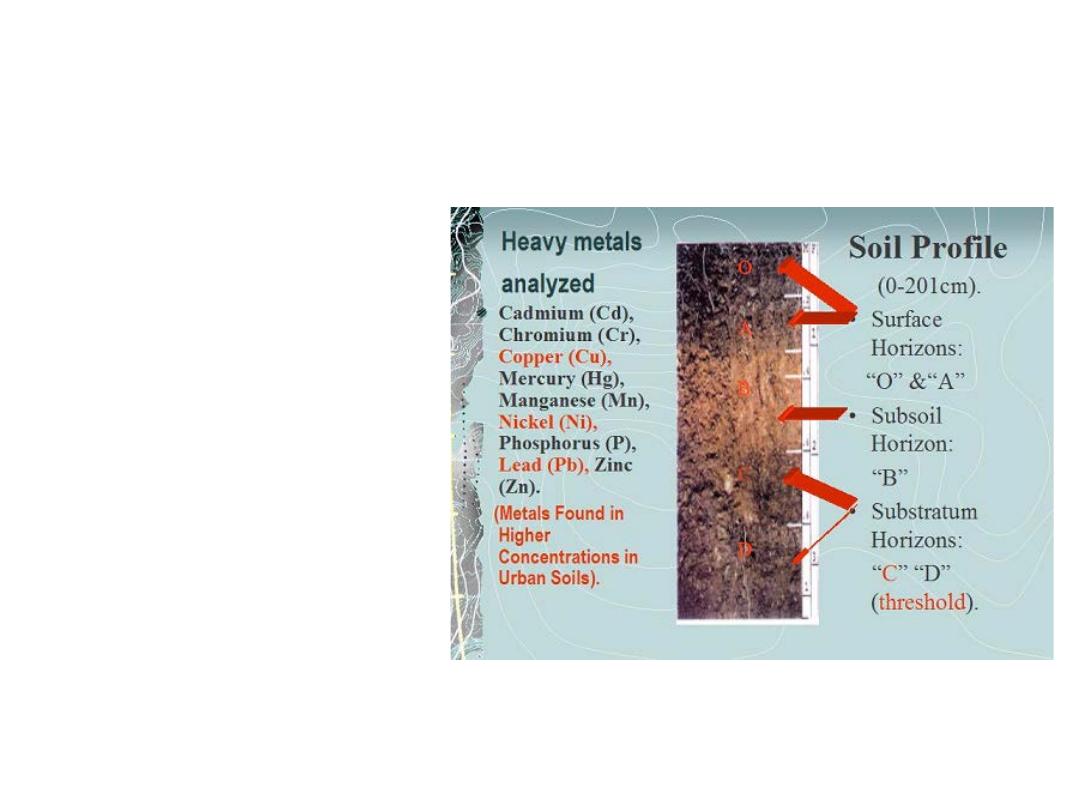
1-May-16
33
Primary Sources: For Heavy Metal Soil
Contamination Include:
•
Fertilizers containing lead
and arsenic .
•
Pesticides containing lead,
arsenic and mercury.
•
Sewage sludge containing
cadmium, arsenic and lead
(Odum, 2000) .
•
Irrigation water may
transport dissolved heavy
metals to agricultural fields
where metals such as
cadmium may be
incorporated into plant
tissue.
•
Atmospheric deposition.
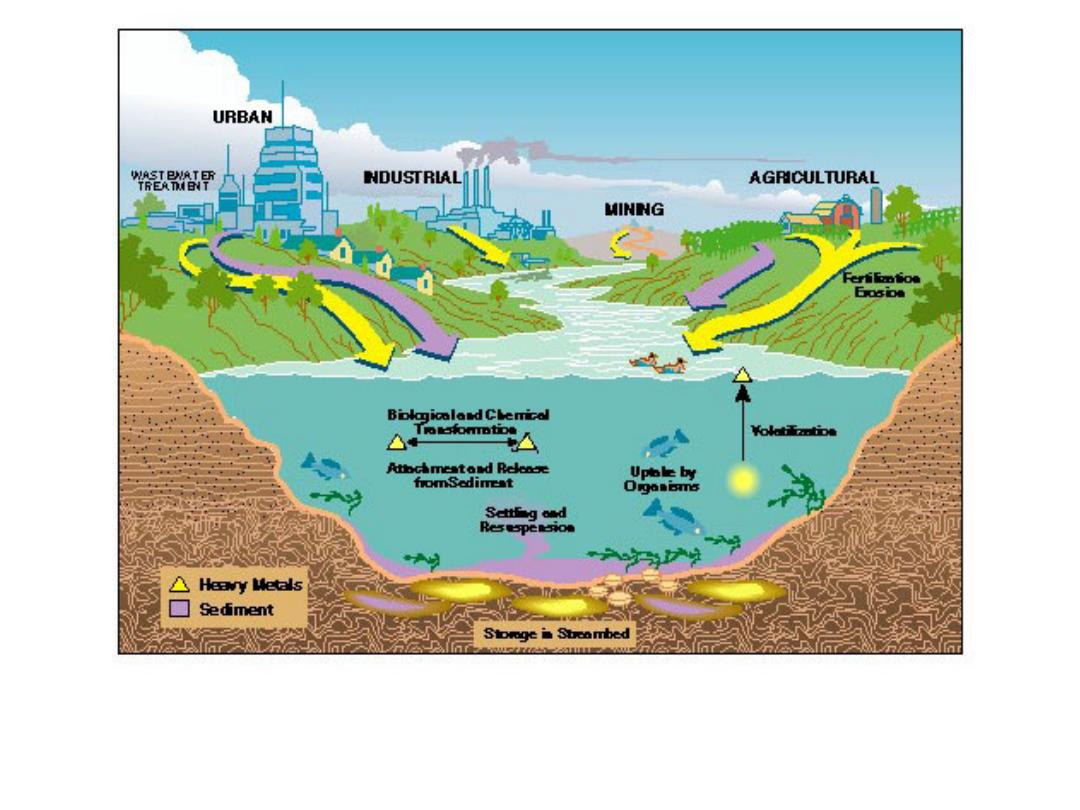
1-May-16
34
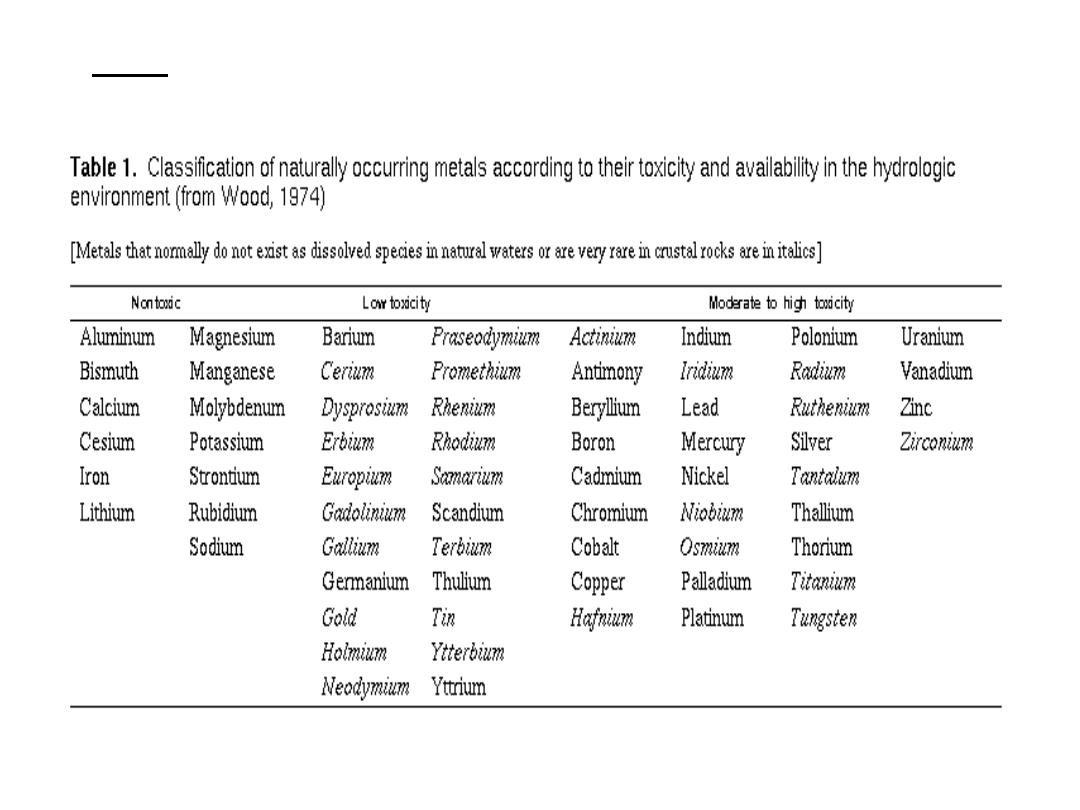
1-May-16
35
Table Lists Metals According to Their Toxicities

1-May-16
36
Lead
*Lead is by far the most common contaminant of soils.
• Lead in soil is virtually a permanent resident. Organic
matter, especially, will bind and hold itself in other metals
very effectively.
•
Of two types
: 1-
Organic
lead (e.g: tetraethyl “antiknock”
and tetramethyl which added to gasoline as octane
boosters, can pentrate skin), lipid soluble so can pass BBB.
2-
Inorganic
lead “commonest type”
-metallic lead used in pipe industry “to prevent corrosion”,
in various alloys, in cable sheathing, in solder as sheathing
material for Ionizing radiation.
-leads oxide used in electric batteries industry, Rubber
manufacture, as paint ingredients and in glass industry.
-lead arsenate which is used as insecticide.

1-May-16
37
Lead Sources
• Number one source contamination:
-lead-based paint
(which has been chipped or scraped off building
exteriors over several decades or centuries.)
• In the past lead paint was available for
use in homes, and lead pipes and/or
lead solder. As a result people can be
exposed to lead on a daily basis; this
exposure is a major pediatric concern

1-May-16
38
Other sources of Lead exposure:
1- gasoline exhaust
2- motor oil
3- automobile tires
4- industrial activity
5- coal combustion, and pesticides.
6- lead soldered food cans, and ceramic glases.
• Lead in plants:
- Absorbed through roots
- Lead builds up in both leaf and root tissue
- Causes lower concentration of chlorophyll
- Lead compounds absorb UV light
- Plants biomass declines, which includes
roots, shoots, and fruits.

1-May-16
39
Sources of Lead either
-I- Environmental
or
-II-
Occupational
I-Environmental sources
• 1. Combustion of tetramethyl in gasoline
• 2. Persistent lead-based paint (children with
Pica)
• 3. Improperly glazed earthenware
• 4. Lead piping (acid rain)
• 5. Solder in food containers
• 6. Moonshine whiskey
• 7. Automobile battery casing

1-May-16
40
II
-Occupational sources of Lead
• 1. Smelters (air concentration may exceed
1000g/m3)
• 2. Storage battery manufacture (50% total U.S.
consumption)
• 3. Welding and cutting lead-painted structures
• 4. Automobile radiator repair
• 5. Production of lead-based paints (6% total
U.S. consumption)
• 6. Frequent use of firearms

1-May-16
41
Lead in human
• Route of entry:
1- inhalation( respiratory route, which is the main route).
2- oral route; specially if the worker are smoker.
3- sometime organic lead can pass through the skin like (tetraethyl
lead).
*inhaled lead will be completely absorbed.
*only 50 – 70% of ingested lead is absorbed but this percent.
increase more in children and pregnant females, fasting
conditions, iron & calcium deficiency.
Almost all lead in blood bound to RBCs and 95% present in bone,
teeth, kidney, bone marrow, liver and brain.
Excretion mainly by kidney or biliary tract, may present in sweating
and milk.

1-May-16
42
Absorption of Lead
-
Gastrointestinal Tract
8% absorbed (adult)
50% absorbed (children)
Ca++, Fe++ decrease absorption
-Respiratory Tract- Particle size,“
Chemical form”
-Skin - Does occur at high exposures.

1-May-16
43
• Health effects:
- Acute toxication: GIT-toxicity is dominant but
encephalopathy may result in childhood renal
damage.
- Chronic toxicity: depend on dose and duration of
exposure, lead may act as enzyme inhibitors like Na-
K-ATPase of erythrocytes which will shortening its
life span.
Main effect of chronic lead poisoning is on blood
cells and nervous system.

1-May-16
44
• Blood effects:
- Anemia is typical symptom in classical lead poisoning “ lead inhibit
Na-K-ATPase in the cell membrane which cause short life span.
- Increase bilirubin and decrease haptoglobin.
- in high concentration of lead there will be hemolytic anemia.
• Peripheral& CNS effects: may be permanent among children “by
ingestion of lead-containing paint flakes” which lead to Acute
encephalopathy& seizure or Chronic effect which lead to decrease
IQ and may be MR.
Insidious effects which cause chronic toxic encephalopathy,
irritability, behavioral change, fatigue and later on peripheral
neuropathy e.g.: wrist palsy.

1-May-16
45
• Adult patients with acute lead poisoning have weak hand
shake, decrease power of the extensor of forearm “lead
palsy” or “Teleky’s sign”, decrease in nerve conduction.
• Chronic exposure may associated with GIT symptoms, e.g.:
nausea, vomiting, diarrhea, periodic colic may continue for
few days “D.Dx as Appendicitis or DU”.
• Blue-gray stain at the gingival edge “lead stain”
• Endocrine effects.
• Renal effects: impaired renal function, amino acid urea,
glucose urea, hyper phosphate urea, hypertension and gout.
• Carcinogenic effects: suspected to cause renal CA.

1-May-16
46
• Signs& symptoms:
- *Mild cases-- mild fatigue, myalgia, lethargy,
abdominal discomfort.
- *Moderate cases– difficult to concentrate,
irritability, tremor, headache, abdominal pain,
vomiting, weight loss and constipation.
- * Severe cases– lead line “blue line” on gingiva,
severe colic, paresis or paralysis, encephalopathy,
seizure, coma and death.

1-May-16
47
• Diagnosis:
- History and exam. “from good knowledge and
practicing of occupational medicine”.
- CBP– anemia “ either normochromic normocytic or
hypochromic microcytic”, normal WBC &
platelates.
- Urine analysis for aminolevuolonic acid.
- Blood lead level for screening and diagnosis.
- Erythrocyte protoporphyrine level “test of choice for
screening asymptomatic individual”.

1-May-16
48
• Control measures:
- Technical control “engineering methods”:
. Substitution with less toxic material
. Good ventilation
. Good house keeping
. Environmental monitoring
- Personal protection “separate eating and drinking
area with providing of washing and changing
facilities.

1-May-16
49
Control measures “contin.”
- Occupational education “instruction, information,
training”.
- Medical control “preemployment, periodic exam.
- Biological monitoring “clinical exam., blood&urine
analysis, record keeping”. Stop worker if B.lead
>=50µg/dl.
- Personal measures: personal protective equipment,
washing, prohibition of smoking in presence of lead.
- Occupational health education: information,
instruction. Training.

1-May-16
50
Treatment of Lead poisoning
• Chelation therapy with DMSA(succimer) for
children with blood lead levels of greater than 45
mcg/dL was approved in 1991 by the FDA.
• A major advantage of DMSA is that it can be given
orally, which leads to better compliance by the
patient. DMSA is relatively safe and significantly
reduces blood levels of iron (Fournier et al. 1988).
• BAL, D-penicillamine, and EDTA are also used
(Wentz 2000). Whole bowel irrigation is used if x-
rays indicate the presence of lead (Ferner 2001).
• Follow-up blood testing is required because stored
lead in bones may continue to release from the bones
when the lead exposure has been long-term

1-May-16
51
Copper
• Copper naturally occurs in soil and plants.
• Copper is a reddish metal that occurs naturally in rock,
soil, water, sediment and air.
• It’s average concentration in the earth’s crust is about
50 parts copper per million parts soil (ppm).
• It is an essential element for all known living
organisms, including humans and other animals.
However, at high concentrations, copper is toxic.

1-May-16
52
Copper Sources
• Copper is released into the environment by mining,
farming, and manufacturing operations and through
waste water releases into rivers and lakes.
• It is also released from natural sources:
– Volcanoes
– Windblown dusts
– Decaying vegetation
– Forest fires
• Copper released into the environment usually attaches
to particles made of organic matter, clay, soil, or sand.

1-May-16
53
Copper in Plants
• Signs of copper deficiencies
– Wilted leaves
– Chlorosis (yellowing of leaves)
– Root rot
• Functions
– Important for reproductive growth
• Chlorophyll production
• Protein synthesis
• respiration
– Aids in root metabolism
– Helps in utilization of proteins

1-May-16
54
Copper in human
• Used in electrical equipment & alloy and in
plumbing
ﺍﻟﺳﺑﺎﻛﻪand heating.
• Inhalation of fumes will result in metal
fever and respiratory irritation.
• Accumulation of Copper in the liver will
lead to hepatolenticular fibrosis “Wilson
disease”.

1-May-16
55
MERCURY (Hg)
*
Metallic Mercury
: is used in manufacture of
thermometer, electrical equipment, fluorescent light
tube, production of chlorine and amalgam.
“Mercury may evaporate at room temperature”
--
Organic mercury
: “alkyl Hg as seeds-dressing
“fungicide” as seed grain preservative
--
Inorganic mercury
: “Hg bromide” red oxide paint,
also used inorganic pesticide.

1-May-16
56
Route of entry of
MERCURY
• 1. Inhalation of Hg vapor “very important” in
industry, mining (risk from metallic Hg),
broken scientific instruments in labs or dentist
clinic → vaporize Hg at room temperature.
• 2. Through intact skin.
• 3. Rarely ingestion.
* Metabolism: 80% of Hg vapor absorbed from
the lung. Methyl Hg absorb from GIT. Higher
absorption rate in newborn.

1-May-16
57
• Distribution between plasma and RBC, but 90%
of organic Hg bounded to cells.
• Organic Hg “lipophilic” can cross BBB and
placenta while inorganic Hg cannot. Hg is
mainly concentrated in kidney, liver and to
lesser extent in brain.
• Excretion: -Urine specially for inorganic Hg.
-Feces specially for methyl Hg.
- Sweat, Saliva, Breast milk.

1-May-16
58
Clinical features of
MERCURY
poisoning
• Acute poisoning: -
acute Hg vapor→ sever
airway irritation and pulmonary edema
“pulmonary dis. is the usual cause of deaths due
to diffuse interstitial fibrosis”
(S/S → fever,
cough, dyspnea, tachypnea).
-
CNS involvement → Tremor.
-
Hg ingestion → N&V, abd.pain, bloody
diarrhea, shock, acute renal dysfunction with
uremia may occur.
-
Cutaneous exposure →contact dermititis.

1-May-16
59
Chronic poisoning of MERCURY
• S&S appear 2 WKs---Years after exposure depending
on type of Hg and degree of exposure.
•
Effect usually on→central and peripheral NS
→ kidney “nephrotic synd. →RF”
→oral cavity “sever inflam.grey border in gingival
edge, loosen teeth,↑salivation, metallic taste”
- organic Hg
→mainly neurological symptom “fine
intention tremor, parasthesia, cerebellar ataxia”.
- inorganic Hg
→mainly psychiatric symptom “irritability,
insomnia, concentration difficulty, ↓memory and
depression.
Acrodynia or “Pink dis.’ occur in infants or children.

1-May-16
60
• Diagnosis
of Hg poisoning:
- History &clinical exam.
- Blood & urine exam. for Hg.
- Further exam.of hair and nail.
- * e.g., on environmental Hg poisoning as what occur
in Iraq during 1970s through seed-grain treated with
methyl and ethyl Hg.
• Treatment
:-chelating agent:BAL&CaEDTA
-Supportive ®
→speech + physiotherapy
• Prevention
→
:either-Technical,or-personal,or-
medical and education.

1-May-16
61
*
Aluminum poisoning
• Most common metal in the earths’crust.
•
Light metal with high resist to corrosion→used in light
metal alloys.
• Used in kitchen ware, automobile body, aircraft industry,
but most intense aluminum exposure occur in Al-
refineries “metal production by electrolysis”.
• Also used in flocculation of drinking water.
•
Aerosol exposure →conjunctivitis, eczema &upper
airway irritation.
•
Several occup.exposure →pulmonary changes “shavers
dis.” irregular opacity in CXR.(S/S dyspnea and dry
cough).

1-May-16
62
• Aluminum poisoning (contin.)
•
Patients undergo dialysis →little ability to excrete
Aluminum →accumulation in body →neurotoxicity
→dialysis dementia →early symptoms →speech
impairment& dysphasia, followed by followed by
myoclonic movement &seizures, then progressive
global dementia “prominent symptoms of parietal lobe”
→irreversible dis. →may die after few years.
• Also dialysis osteodystrophy in 2% of patients undergo
long term dialysis →osteoporosis, skeletal pain and
multiple fractures.
• Few cases of osteomalacia have been recorded with long
term use of Aluminum as antacid.

1-May-16
63
*
ARSENIC POISONING
• Occur widely in environment and food
“specially well-water”
•
Occupational exposure→metal smelting where
arsenic occur as a contaminant or by product,
production and use of various alloys specially
Lead and Copper, production and use of
pesticide.
•
Acute intoxication →GIT symptoms, fever,
cardio toxicity, peripheral edema and shock
→death 12-48 hrs. if survive →leukemia,
anemia and peripheral nerve damage 1-2 wks
later.

1-May-16
64
ARSENIC POISONING (contin.)
Late effect: loss of hair, nail deformity and peripheral
neuropathy.
Chronic exposure to skin →eczema →hyperkeratosis
→skin CA “SQUAMOUS CELL CRCINOMA”,
Raynaud’s dis., Acrocyanosis+ necrosis “Black Foot
Disease”. Also increase risk of CA lung.
• *BARIUM POISONIN
• Heaviest of the stable earth alkaline.
• Used in drilling muds, ceramic glazes, paper coaling &
pesticide.
• Mainly accumulate in the skeleton
• Use of Barium sulfate as X Ray contrast is generally
safe.

1-May-16
65
*
BERYLLIUM POISONING
•
Occupational exposure→production of
“fluorescent lamps”
• Inhalation “major hazard”
→ chemical
pneumonia if progress it is lethal.
• Chronic dis. “Beryllosis” similar to Sarcoidosis
→ pulmonary granulomatosis most frequent
symptom is dyspnea on exertion.
• May be considered as a carcinogen.

1-May-16
66
*
CADMIUM POISONING
•
Occupational exposure → corrosion treatment of
metals especially Iron& Steal.
• Nickle Cadmium Batteries “rechargeable”
• In nuclear-power plant
• In plastic &rubber industry
• GIT absorption is more in patients with Iron
deficiency anemia
• Mainly store in liver& excreted in kidney

1-May-16
67
•
CADMIUM POISONING (contin.)
• Biological half life 10 years
• Acute poisoning “inhalation of fumes”
→slowly developed symptom →fever& toxic
pneumonitis,
• GIT symtom may appear
•
Long term pois. →mainly accum.in kidney
→damage of proximal tubules →proteinurea,
mild anemia, anosmia, abnormal liver
function.
• May cause CAlung.

1-May-16
68
*CHROMIUM POISONING
• Present in daily food “trace metal, small amount”
•
Occupational exposure →stainless steel, metal alloy
→corrosion of skin and mucous membrane, allergic
response “contact dermititis”, irritation of airway
“pneumoconiosis” and carcinogenicity of skin&
respiratory tract.
• Chromium may cause circumscribe ulcer “chrome hole”
at the knuckles, nail root or other exposed skin, are
almost painless, healing take several weeks, leaving
depressed scare.

1-May-16
69
*COBALT POISONING
• ESSENTIAL MICRONUTRIENT
•
Occupational exposure → hard metal manifacturing
•
Inhalation → airway irritation, asthma and interstitial
fibrosis →COPD
• Skin allergy and hand eczema
• Goitrogenic and thyroid hyperplasia
• Cardiotoxicity is perhaps an important hazard
• *IRON
5% of earth crust
• Chronic overload
→hemosiderosis
• Fume inhalation “in worker of grinders& welder”
→siderosis “accumulation in lung” and
pneumoconiosis.

1-May-16
70
*NICKEL POISONING
• Used in alloys
• Occupational exposure in stainless steel &welding
workers
• Has limited toxicity, but important adverse effects
related to allergic eczema and respiratory cancer “nasal
and lung CA”
• Nickel allergy is the most frequent cause of contact
eczema.
• *SILVER:
used in alloy, jewelry, silver ware and
photographic emulsion.
• ARGYRIA: Bluish discoloration of the skin due to
deposition of silver metal particle.
• There are pulmonary and ocular Argyrosis.

1-May-16
71
GOOD LUCK &
THANK YOU
